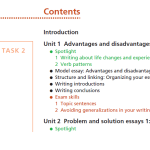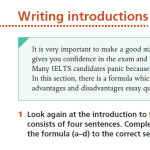 I’m very pleased to finally accept the challenge laid out many months ago – interview someone in your PLN. I present to you a guy who isn’t particularly active online… yet. He doesn’t have a Twitter account and he doesn’t have his own blog… yet. Hopefully we can change his mind about that soon because I know he’s got a lot of really great ideas to share.
I’m very pleased to finally accept the challenge laid out many months ago – interview someone in your PLN. I present to you a guy who isn’t particularly active online… yet. He doesn’t have a Twitter account and he doesn’t have his own blog… yet. Hopefully we can change his mind about that soon because I know he’s got a lot of really great ideas to share.
I first met Lewis Richards in 2008 when I started teaching in Portsmouth, England. With enormous patience, he showed me the ropes with regard to something I was going to have to start teaching soon called Eyelets, or Yelts, or IELTS or something like that. 😉 With another fine colleague of mine, Richard Brown, the two of them set themselves the goal of writing a coursebook. IELTS Advantage: Writing Skills is the result.
So without further ado, I present a multi-talented Lewis Richards!
The Standard 5 Questions
1. If your students were to describe you with 3 adjectives, what would they be?
Hopefully, passionate about teaching, fun, hard-working. But I reckon some would also say strict!
2. What would we find in your refrigerator right now?
Not a lot. Leftovers. Rotting vegetables. It’s lucky you can’t see it, really. (Gordon – I know this can’t be true because Lewis is actually a very good cook!)
3. If you weren’t a teacher, what might your profession be?
Hard to say, I’ve been teaching for so long, and enjoy it so much, that I can’t imagine anything else. But I’ve always enjoyed writing, so maybe journalism.
4. What do you find most difficult about the teaching profession, or What has been your most difficult class as a teacher?
It might sound cheesy, but I’ve enjoyed every class that I’ve taught. But I did have a class a few years back in Moscow of total beginners, and a couple of the students couldn’t read or write in Russian, so it was quite tough to teach them English. We had fun, but I’m not sure we made a great deal of progress.
5. What was the last book/movie you read/saw, and what have you seen/read way too many times?
At the moment, I’m reading Ian McEwan’s ‘Solar’ – I only started reading his books recently, and I love his style and wit. The book I re-read the most is Joseph Heller’s ‘Catch 22’, even the hundredth time around it makes me laugh out loud. A work of genius.
Extra Questions
6. You’ve just finished writing a book with Richard. Why did you write it?
Well, both of us have taught IELTS for a long time, about 15 years between us, and we found that although there are lots of good IELTS books on the market, we couldn’t find a single book that made it easy to teach the writing to students. So we ended up writing our own exercises and material, and over the years accumulated hundreds of our own exercises for the writing part of IELTS. And it’s worked, our students have always done really well in IELTS, particularly in the writing, so we knew that we were on the right track.
A couple of years ago we thought to ourselves ‘well, why don’t we put all these ideas together into a book’, and so we did. We hope it will be really useful for students, and help them to get a 6.5 or above in the writing, and also I think the book is great for IELTS teachers – because it contains everything that students need to get a good score, and it’s quite user-friendly, and hopefully easy to teach with.
7. Who is it for?
We decided to write the book so that students can use it either as a self-study book, because we know that a lot of IELTS candidates just don’t have the time or maybe the money to go to a language school and do an IELTS course. There are a lot of professional people, like nurses and doctors, who need a high score in IELTS, and have good English, but need help with the writing because it’s quite specialised and technical, but because they are working, they don’t really have time to spend a couple of months in a language school. I’ve met lots of students who spoke fantastic English, and got a 7.5 or 8 in the speaking part, but couldn’t manage a high score in the writing, because they hadn’t had any training. Our book will help those people.
Of course, it’s also designed to be used in the class with a teacher – and one of the things we think is really important about the book is that every single exercise in it has been tried out in class many times – so we know that the book works. The aim in terms of a score, is a minimum of 6.5, hopefully more. We also drew on our experience as IELTS writing examiners to show students what is required to get these kinds of scores. One of the things we wanted to put into the book were some real pieces of writing by our students, with our comments and scores, so that students can see what a 7.0 answer, for example, looks like. We hope that these will be really useful.
8. Why are neither of you imparting your knowledge through twitter or a blog yet?
Well, just speaking for myself, I’m not very up with the latest technology, I’m more of a paper and pen man, but I know I should drag myself into the 21st century!
9. What do you like to do to unwind?
I’m really into tennis, I play a few times a week, and find that a really good game gets rid of stress, and keeps me fit. Beer helps too!
10. What’s your favourite place in the world?
I think I’d have to say Paris. Not especially for the landmarks, although it is of course an amazingly beautiful city, but because it was the first place I lived and worked abroad, when I was in my early 20s, and the excitement of learning a language and living in a new culture for the first time is something I’ll never forget.

L'Arc de Triomphe, Paris (Photo from OliverN5 on Flickr)
11. What do you want to do in the next year and how can I help?
There are several ideas for other books in the pipeline, but it’s a bit early to say exactly what at the moment. But, probably some more writing, along with teaching, of course. Feel free to keep talking about our books on your great website!
Final Question
12. Next time we see each other, whose round is it, what’s everyone having and where will we have it?
Well, I think it’s definitely my round – you’re actually a rare Scot who’s very generous with money, so I’m sure I owe you a few! Summertime, a nice cold beer, somewhere by the sea sounds perfect!

Looking forward to it! Photo from bovinity on Flickr













